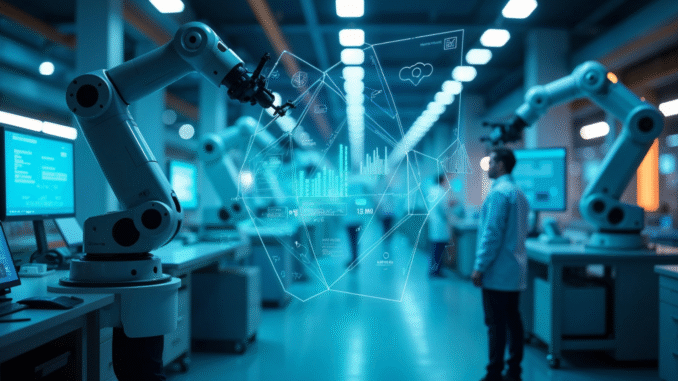
The Digital Frontier: Exploring the Impact of AI, Robotics, and Smart Tech in 2025
The digital revolution is accelerating faster than ever before. What was once science fiction is now shaping our everyday lives—artificial intelligence, robotics, and smart technology are transforming industries, economies, and human experiences across the globe. As we move deeper into 2025, these technologies have evolved from emerging innovations into essential forces that define modern civilization.
This new era—often called the Digital Frontier—is not just about automation or connectivity. It’s about creating a world where intelligence, efficiency, and sustainability converge. Let’s explore how AI, robotics, and smart technologies are impacting society, the economy, and the future of innovation in 2025 and beyond.
1. Artificial Intelligence: The Power Behind the Digital Age
Artificial Intelligence (AI) has rapidly become the cornerstone of technological progress. In 2025, it’s not just a buzzword—it’s the backbone of countless industries. From predictive analytics and natural language processing to creative content generation, AI is driving transformation at every level of society.
In business, AI systems now handle complex decision-making tasks that once required human expertise. Companies rely on AI to forecast market trends, optimize logistics, and personalize customer experiences. For example, retail giants use AI-driven algorithms to predict consumer behavior and adjust inventory in real time, saving millions in operational costs.
In healthcare, AI tools are revolutionizing diagnostics and patient care. Machine learning algorithms analyze medical images faster and more accurately than humans, while predictive models help doctors anticipate disease progression. AI-powered chatbots and virtual assistants also provide round-the-clock support for patients, improving accessibility to healthcare services.
In education, AI is personalizing learning like never before. Adaptive learning platforms analyze student performance data to tailor lessons according to each individual’s strengths and weaknesses. This approach enhances learning efficiency and student engagement, preparing the next generation for the challenges of a tech-driven world.
2. Robotics: Redefining the Modern Workforce
Robots are no longer confined to factories—they are becoming integral to everyday life. In 2025, robotics is reshaping industries such as manufacturing, healthcare, agriculture, and even entertainment. These intelligent machines are improving productivity, safety, and precision in ways humans alone cannot achieve.
In manufacturing, robotics and automation have entered a new phase known as Industry 4.0. Smart factories use collaborative robots—“cobots”—that work alongside human workers to handle repetitive or dangerous tasks. This collaboration increases efficiency, reduces errors, and creates safer work environments.
In healthcare, robotic-assisted surgeries allow doctors to perform delicate operations with microscopic precision. Rehabilitation robots help patients regain mobility, while AI-powered robotic nurses assist with patient monitoring and medication distribution.
In agriculture, drones and autonomous robots are revolutionizing farming. They monitor soil health, detect crop diseases, and optimize irrigation systems, ensuring sustainability and higher yields. These innovations are particularly crucial as the world faces growing food demand and environmental challenges.
The rise of robotics does raise concerns about job displacement, but history shows that every technological revolution creates new opportunities. The key lies in upskilling the workforce—training humans to work alongside robots rather than compete against them.
3. Smart Technology: The Connected World of 2025
Smart technology has woven itself into the fabric of daily life. From homes and cities to vehicles and workplaces, “smart” systems are improving comfort, security, and efficiency. The combination of Internet of Things (IoT) and 5G connectivity has unlocked a world where everything is connected, data-driven, and intelligent.
Smart homes are no longer futuristic fantasies. Voice-controlled devices, automated lighting, smart thermostats, and AI-powered security cameras have made modern living more convenient and energy-efficient. These systems not only respond to user commands but also learn from habits—adjusting temperature, lighting, and schedules automatically.
Smart cities represent the next step in urban evolution. IoT sensors monitor traffic flow, air quality, waste management, and public safety. Real-time data analysis helps city officials make informed decisions, reduce congestion, and enhance sustainability. Citizens benefit from improved transportation, cleaner environments, and smarter infrastructure.
Smart vehicles are another revolutionary development. Autonomous cars, connected through 5G networks, are making transportation safer and more efficient. Advanced driver-assistance systems (ADAS) prevent accidents, while real-time navigation and predictive maintenance reduce costs and emissions. By 2025, major cities are already seeing pilot programs for fully autonomous public transport systems.
4. The Convergence of AI, Robotics, and Smart Tech
While each of these technologies—AI, robotics, and smart systems—has immense individual impact, their true power lies in convergence. Together, they are creating ecosystems that think, learn, and act autonomously.
For example, consider a smart factory:
- AI algorithms manage production schedules and predict equipment failures.
- Robots perform manufacturing tasks with precision and adaptability.
- IoT sensors collect data from every machine, optimizing workflow and resource use.
Similarly, in healthcare, AI analyzes medical data, robotics assist in surgery, and IoT devices track patient vitals remotely. The integration of these systems ensures seamless coordination, reducing human error and enhancing overall outcomes.
This convergence is also evident in smart agriculture, where AI analyzes soil and weather data, drones survey crops, and robotic harvesters automate farming. The result is a sustainable, data-driven ecosystem that supports food security and environmental health.
5. The Human Side of the Digital Revolution
As technology becomes more advanced, the question arises: where do humans fit into this digital future? Contrary to the fear that machines will replace people, 2025 has shown that the future of work is collaborative, not competitive.
AI and robotics are taking over repetitive, dangerous, or data-heavy tasks—freeing humans to focus on creativity, innovation, and strategic thinking. This shift is giving rise to new roles in areas such as AI ethics, data science, digital security, and human-machine interaction design.
The emphasis on emotional intelligence, critical thinking, and ethical leadership is growing. These uniquely human skills will remain invaluable in guiding technology toward responsible and inclusive growth.
6. Ethical and Social Implications
While the digital frontier offers immense promise, it also poses serious ethical and social challenges. Issues such as data privacy, AI bias, automation-driven unemployment, and the digital divide must be addressed thoughtfully.
Data privacy is one of the most pressing concerns. With millions of devices collecting personal information, governments and corporations face increasing pressure to ensure transparency and data security.
AI bias can occur when algorithms are trained on incomplete or biased data sets, leading to unfair decisions in hiring, lending, or law enforcement. As AI becomes more embedded in society, ensuring fairness and accountability is essential.
Automation and job displacement remain ongoing concerns. While technology creates new opportunities, it also disrupts traditional employment structures. Governments and educational institutions must prioritize reskilling and lifelong learning to prepare workers for the digital economy.
Bridging the digital divide is another critical challenge. Access to technology remains unequal across regions and populations. To ensure that innovation benefits everyone, global collaboration and inclusive digital policies are necessary.
7. The Role of Innovation in Sustainability
One of the most encouraging trends in 2025 is the alignment of technology with sustainability. AI, robotics, and smart systems are being used to combat climate change, optimize energy consumption, and preserve natural resources.
- AI-powered climate models predict weather patterns and assist in disaster management.
- Smart grids balance electricity demand and integrate renewable energy sources efficiently.
- Robotic systems clean oceans, plant trees, and monitor wildlife habitats.
Sustainability is no longer just a goal—it’s a guiding principle for technological development. As industries adopt greener practices, innovation becomes a force for environmental restoration as well as economic growth.
8. The Future: A Human-Centric Digital World
The digital frontier of 2025 is just the beginning. Over the next decade, the boundaries between the physical and digital worlds will blur even further. Technologies like quantum computing, extended reality (XR), and neural interfaces will redefine human potential.
However, the future of technology must remain human-centric. As AI and robotics grow more powerful, their purpose should always be to enhance human life, not replace it. Ethical design, inclusivity, and empathy must guide innovation to ensure that technology uplifts all of humanity.
Conclusion
As we navigate 2025, the world stands at the heart of the Digital Frontier—a landscape powered by AI, robotics, and smart technology. These innovations are reshaping industries, improving quality of life, and addressing some of humanity’s most complex challenges.
Yet, with great power comes great responsibility. The success of this digital era will depend on how wisely we harness technology—balancing progress with ethics, automation with empathy, and innovation with inclusivity.
The future is not something we enter—it’s something we create. And in this new frontier, our collective creativity, responsibility, and vision will determine the shape of the world for generations to come.

